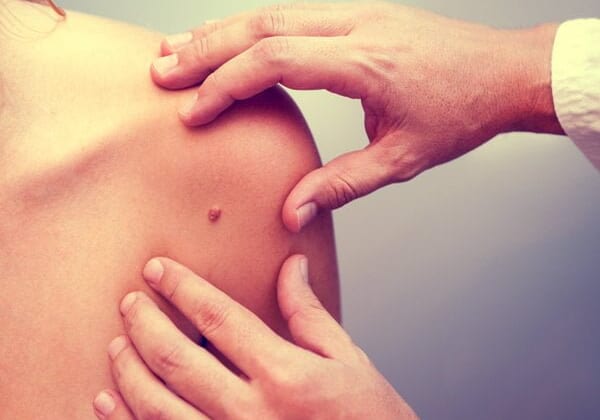
Nearly everyone has some sort of spot or mole on their body. For some, a speckled face or body is just part of living in their skin, but the spots can also turn into a dangerous cancer called melanoma. Fortunately, melanoma accounts for relatively few cases of cancer and is highly treatable when caught early. Catching it early is key, though; so you should look into any suspicious moles or spots right away.
According to the American Cancer Society, 87,000 new cases of melanoma will be diagnosed in 2017 and as many as 9,700 people will die from the cancer. Although melanoma only makes up about 1 percent of skin cancer cases, it clearly affects many lives and should be taken seriously.
What Is Melanoma?
Melanoma is a cancerous growth that occurs because of unrepaired DNA damage to skin cells. Like other cancers, these damaged cells mutate and then grow out of control.
The damage often happens due to ultraviolet radiation from sun exposure or tanning beds. In some cases, though, a person may have an inherited trait or skin disorder that inhibits the body from repairing the damaged skin cells.
Risk factors for melanoma include excessive UV light exposure, moles (especially if there are many), family history, fair skin or a weakened immune system.
Spotting Melanoma Early
Unlike many other cancers, melanoma can often be identified first by the patient and then verified later by a medical professional. To determine whether to get expert advice, you can search for 5 common identifying factors, outlined by the National Cancer Institute as the ABC’s of melanoma.
- Asymmetry
When judging asymmetry in a mole or spot, imagine that a line is dividing the mole down the middle. If one side of the mole does not match the shape and color of the other side, it may be cancerous. Get expert advice immediately.
2. Border
A regular freckle or mole on the skin will usually have a defined edge to it. However, melanoma often blurs or fades into the surrounding skin or has jagged edges.
3. Color
You can often identify melanoma because of its inconsistent color or shade. Again, normal spots will have a consistent color and darkness throughout.
For example, the spot may look darker brown in the middle than on the edges. You may also notice white, red or pink spots.
4. Diameter
The diameter is the width across the entire mole or spot. Generally, melanoma gets bigger, resulting in a spot larger than the size of a pea. If you notice a mole or spot growing or spreading out on the skin, consult your doctor.
5. Evolving
Last, look for changes in the spot over the last few weeks or months. Normal moles or spots won’t change in color, size or shape.
By using these 5 easy criteria, you can judge whether a skin spot needs medical evaluation. While you likely have nothing to worry about, you should check into any suspicious areas as a precaution.
After Diagnosis
Because melanoma starts out in a localized area, it can easily be treated in its early stages. If you catch it early, you may only need surgery to remove the cancer. After the surgery, you will also need to follow up with your dermatologist on a regular basis.
On the other hand, if the cancer travels deeper within the skin, it may have already spread through the blood vessels and lymphatic system. This later stage of melanoma proves more difficult to treat. You will need to discuss treatment options such as chemotherapy with your doctor based on your specific case.
Skin Cancer Prevention
Doctors have seen a rise in melanoma in the US in the last several decades. While older people have a much higher risk of developing melanoma, more young adults are acquiring the cancer as well.
As with any cancer, the best method for fighting melanoma is prevention. Follow these steps to reduce your risk for this skin cancer:
- Use sun protection.
When going outdoors, use proper protection for your skin, including hats, sunglasses, sunscreen and clothing that covers much of the body.
- Avoid tanning beds and sunlamps.
These artificial sources of UV rays are just as harmful to the skin as UV light from the sun.
- Check your skin.
Make it a habit to regularly inspect your skin and get familiar with your spots and moles.
- Keep your immune system strong.
Avoid practices that increase your risk for immune-suppressing diseases like HIV. In addition, exercise, get proper rest and eat a well-balanced diet to help your body fend off disease.
Although you likely have a harmless mole or two in some area of your body, you should watch for signs of melanoma. When caught early, melanoma can be easy to treat and overcome. However, the absolute best method of fighting melanoma is through prevention. By maintaining a healthy lifestyle and protecting your skin from the sun, you will dramatically decrease your risk for getting this skin cancer.
